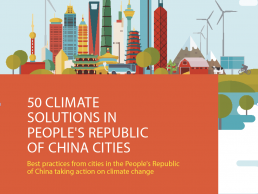Featured in

50 Climate Solutions of Cities in the People's Republic of China
50 climate solutions from cities in the People's Republic of China
By Ayumi Konishi,Senior Advisor to the President, Asian Development Bank
The People's Republic of China is giving the green light to tackling climate change and improving life in its ever-growing cities
The People’s Republic of China (PRC) has sustained spectacular economic growth over the past three decades. Gross domestic product (GDP) growth has averaged 9.7%, and per capita income has increased 8.6% per year between 1980 and 2016. The PRC’s high rate of economic growth and improvement in the economy was coupled with rapid urbanization. The PRC’s urban population reached 56.1% in April 2016 and is expected to reach 60% by 2020. This growth and urbanization has led to great improvement in living standards, but placed pressure on the consumption of energy and natural resources, resulting in serious challenges relating to the environment and climate change – for example, the PRC is ranked as the top emitter of greenhouse gases globally. In large urban centers this has led to poor air and water quality, affecting the health of the urban population. The cost of pollution damage in the PRC is estimated to be close to 10% of GDP.
Now, the PRC recognizes transformation in its growth pattern and targets ‘Xiao Kang (moderately prosperous soci- ety)’ by 2020, promoting sustainable, inclusive, low carbon, and resilient growth. Recognizing the need to improve the urban environment and the critical role that cities play in mitigating the effects of climate change, the PRC has identified and implemented several city-level initiatives for sustainable development. Initiatives have included measures to conserve energy, reduce emissions, increase mass-transit and non-motorized transport infrastructure, introduce new-energy vehicles, increase green infrastructure, rehabilitate wetlands and improve flood protection, among others. One key initiative is the “Low-Carbon Cities Initiatives” led by the National Reform and Development Commission (NDRC). Since its inception in 2005, a total of 87 low-carbon pilot provinces, cities and districts have been designated under the initiative. This initiative directly links to the PRC’s target to peak greenhouse gas (GHG) emissions by 2030 under its Nationally Determined Contributions to Climate Change.
Under the PRC’s drive for low-carbon cities, they have successfully implemented effective GHG reduction and environmental improvement measures while continuing to ensure economic prosperity. This publication showcas- es several urban case studies from the PRC that demonstrate innovative approaches to reducing carbon emissions and mitigating the effects of climate change. Sharing these best-practice examples will enable other cities that face similar challenges to build on the success and lessons learned to develop their own road maps for low-carbon urban development.
Facts


